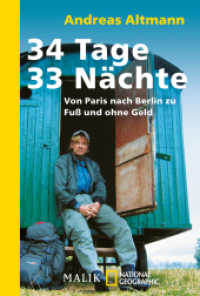- ホーム
- > 洋書
- > 英文書
- > Science / Mathematics
Full Description
The second edition of this volume has been extensively revised. A different version of Chap. 7, reflecting recent significant progress in understanding of spatiotempo- ral chaos, is now provided. Much new material has been included in the sections dealing with intermittency in birth-death models and noise-induced phase transi- tions. A new section on control of chaotic behavior has been added to Chap. 6. The subtitle of the volume has been changed to better reflect its contents. We acknowledge stimulating discussions with H. Haken and E. Scholl and are grateful to our colleagues M. Bar, D. Battogtokh, M. Eiswirth, M. Hildebrand, K. Krischer, and V. Tereshko for their comments and assistance. We thank M. Lubke for her help in producing new figures for this volume. Berlin and Moscow A. s. Mikhailov April 1996 A. Yu. Loskutov Preface to the First Edition This textbook is based on a lecture course in synergetics given at the University of Moscow. In this second of two volumes, we discuss the emergence and properties of complex chaotic patterns in distributed active systems.
Such patterns can be produced autonomously by a system, or can result from selective amplification of fluctuations caused by external weak noise.
Contents
1. Introduction.- 1.1 Chaotic Dynamics.- 1.2 Noise-Induced Complex Patterns.- 1.3 Chaos, Noise, and Self-Organization.- 2. Unpredictable Dynamics.- 2.1 Hamiltonian Systems.- 2.2 Destruction of Tori.- 2.3 Ergodicity and Mixing.- 3. Strange Attractors.- 3.1 Dissipative Systems and Their Attractors.- 3.2 The Lorenz Model.- 3.3 Lyapunov Exponents.- 3.4 The Autocorrelation Function.- 4. Fractals.- 4.1 Self-Similar Patterns.- 4.2 Fractal Dimensions.- 4.3 Dimensions of Strange Attractors and Fractal Basin Boundaries.- 5. Iterative Maps.- 5.1 Fixed Points and Cycles.- 5.2 Chaotic Maps.- 5.3 Feigenbaum Universality.- 6. Routes to Temporal Chaos.- 6.1 Bifurcations.- 6.2 The Ruelle-Takens Scenario.- 6.3 Period Doubling.- 6.4 Intermittency.- 6.5 Controlling Chaotic Behavior.- 7. Spatiotemporal Chaos.- 7.1 Analysis of Time Series.- 7.2 Turbulence in Distributed Active Systems.- 7.3 Coupled Chaotic Maps.- 7.4 The Complex Ginzburg-Landau Equation.- 7.5 Statistics of Defects.- 7.6 Transient Turbulence.- 8. Random Processes.- 8.1 Probabilistic Automata.- 8.2 Continuous Random Processes.- 8.3 The Fokker-Planck Equation.- 9. Active Systems with Noise.- 9.1 Generalized Brownian Motion.- 9.2 Internal Noise.- 9.3 Optimal Fluctuations and Transition Probabilities.- 10. Birth-Death Systems.- 10.1 Stochastic Birth-Death Models.- 10.2 The Ignition Problem.- 10.3 Spatiotemporal Intermittency in Population Explosions.- 10.4 Explosions in Media with Random Breeding Centers.- 11. Extinction and Complex Relaxation.- 11.1 Diffusion with Random Traps.- 11.2 Irreversible Annihilation.- 11.3 Conserved Quantities and Long-Time Relaxation.- 11.4 Stochastic Segregation.- 12. Nonequilibrium Phase Transitions.- 12.1 Second-Order Phase Transitions.- 12.2 Sweeping Through the Critical Region.- 12.3 The Biased Transition.- 12.4 Medium-Populating Transitions.- 12.5 Noise-Induced Phase Transitions: Competition and Coexistence in the Fluctuating Environment.- References.


![S.O.D.H. [Study of Obesity, Diabetes, Hypertension] (2013. 60 S. 220 mm)](../images/goods/ar/work/imgdatak/36593/3659394629.jpg)





